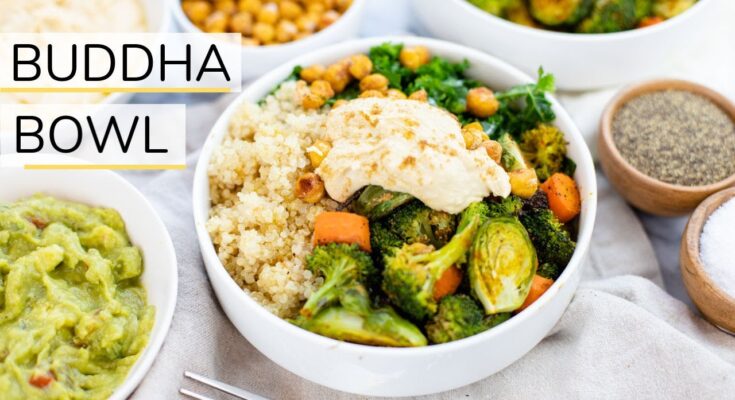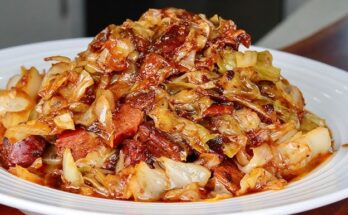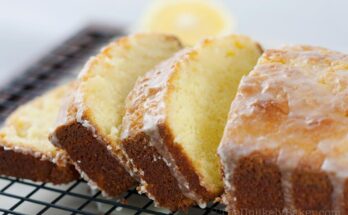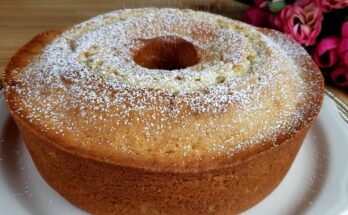Buddha Bowl Recipe: Ever stared into your fridge and thought, “What can I throw together that’s healthy, colorful, and still tastes amazing?” That’s where the magic of a Buddha Bowl comes in. This dish isn’t just a trend—it’s a lifestyle meal. Think of it like a personal canvas of whole foods: vibrant veggies, hearty grains, tasty proteins, and a drizzle of zingy dressing, all nestled together in one beautiful bowl. No rules, just balance.
The term “Buddha Bowl” might conjure images of zen monks or minimalist meals, but really, it’s about mindfulness—taking a variety of healthy, nourishing foods and eating with intention. These bowls are the ultimate fusion of nutrition and flavor, where every bite offers a different texture and taste.
The popularity of Buddha bowls has skyrocketed in recent years for good reason: they’re easy to make, totally customizable, and perfect for everything from meal prep to casual dinner with friends. Whether you’re vegan, vegetarian, gluten-free, or just hungry—there’s a Buddha bowl with your name on it. And don’t worry, if you’re new to this, we’ve got you. This guide will walk you through every step so you can master the art of building the perfect Buddha bowl at home.
List of Ingredients You’ll Need
Alright, let’s break it down. A great Buddha bowl is built on five core components:
1. A Solid Base
You need something hearty to start. This could be:
- Cooked quinoa
- Brown rice
- Wild rice
- Farro
- Cauliflower rice (if you’re going low-carb)
- Leafy greens like kale, spinach, or arugula
2. Protein Power
This is what keeps you full. Choose from:
- Roasted chickpeas
- Tofu (grilled, baked, or crispy)
- Tempeh
- Lentils
- Grilled chicken or salmon (if you’re not vegetarian)
3. Veggie Variety
Raw, roasted, or steamed—just mix them up:
- Carrots (spiralized or shredded)
- Beets (roasted or pickled)
- Cucumber slices
- Roasted sweet potatoes
- Bell peppers
- Broccoli or cauliflower florets
4. Healthy Fats
Fats bring flavor and satiety:
- Avocado slices
- Tahini drizzle
- Chopped nuts (almonds, walnuts, peanuts)
- Seeds (chia, flax, hemp, sesame)
5. Toppings & Dressing
This is where the magic happens:
- Pickled onions
- Fresh herbs (cilantro, parsley, mint)
- Nutritional yeast
- Homemade or store-bought dressing (more on that later)
Pro Tip: Mix and match from each category, and aim for balance in flavor, color, and nutrition.
Choosing the Base
The base is your canvas, so start with something filling and fibrous. Here are a few top picks:
Quinoa
A complete protein and gluten-free, quinoa cooks fast and absorbs flavor well. Bonus: it’s super fluffy and light.
Brown Rice
Nutty, chewy, and full of fiber. It’s a classic Buddha bowl base and keeps you full longer.
Cauliflower Rice
Trying to cut carbs? Cauliflower rice gives you a veggie boost and a mild flavor that pairs with just about anything.
Leafy Greens
Not feeling grains? Go green! A handful of spinach, kale, or mixed greens adds freshness and crunch.
When building your bowl, aim for roughly ½ to 1 cup of cooked base depending on your hunger level. Remember, this is your foundation—make it solid.
Protein Power: Making it Filling
Let’s be real—you don’t want to be hungry 20 minutes after eating. That’s where protein steps in. Here’s how to do it right:
Chickpeas
Roasted with a touch of olive oil, paprika, and garlic powder? Yes, please. Chickpeas are high in fiber and protein and add a crunchy texture.
Tofu
Press it, marinate it, then grill or air-fry it. Crispy tofu is a vegan dream, and it soaks up flavors like a sponge.
Tempeh
A fermented soy product, tempeh has a nutty flavor and a meaty texture. Slice it thin, marinate in soy sauce and maple syrup, then pan-fry.
Animal-Based Options
If you’re not vegetarian, add grilled chicken, salmon, or even a soft-boiled egg. It’s all about what fuels you.
Tip: Add about ½ cup to 1 cup of your chosen protein. Keep it balanced, not overloaded.
Veggies for Color and Crunch
Here’s where you get to have fun. The vegetable part of a Buddha bowl isn’t just for color—though that rainbow look is a huge part of the appeal—it’s for crunch, freshness, and loads of nutrients. You want a combo of textures: something soft, something crisp, maybe something roasted. Variety is the key.
Raw Veggies
Fresh and crunchy. Think:
- Shredded carrots
- Thinly sliced cucumbers
- Cherry tomatoes
- Shaved red cabbage
- Spinach or arugula
- Julienned bell peppers
They add hydration, crunch, and that “fresh” factor. You don’t even need to cook them—just slice and toss in.
Roasted Veggies
Roasting brings out the natural sweetness of vegetables and adds depth.
- Sweet potatoes with a bit of cinnamon and olive oil
- Cauliflower tossed in curry powder and roasted to golden perfection
- Brussels sprouts, halved and roasted until crispy
- Beets—earthy, sweet, and incredibly nutritious
Roasted vegetables can be meal-prepped in advance and added cold or reheated slightly before assembling your bowl.
Steamed or Sautéed
Want something a little softer? Lightly steam broccoli, zucchini, or green beans. Or go with sautéed mushrooms with garlic for a umami bomb.
Color Tip: Aim for at least three different colors of veggies. Not just for aesthetics, but to get a variety of antioxidants and nutrients.
Healthy Fats Matter
Now that your bowl has grains, protein, and veggies, let’s make it satisfying. Healthy fats aren’t just a “nice to have”—they’re essential. They help you absorb fat-soluble vitamins (like A, D, E, and K), and they give that rich mouthfeel we all crave.
Avocado
Creamy, buttery, and oh-so-satisfying. Add a few slices or even mash it up with lime juice and sea salt for a mini guac moment.
Nuts & Seeds
Sprinkle in:
- Pumpkin seeds (pepitas) – crunchy and full of zinc
- Sesame seeds – add a nutty flavor, especially when toasted
- Chopped almonds or cashews – for crunch
- Chia or flax seeds – for omega-3s and fiber
Olive Oil or Nut Butter Drizzle
A small drizzle of extra virgin olive oil, tahini, or even a peanut butter-based dressing gives your bowl depth and ties everything together.
The goal isn’t to overload it with fat, but to add just enough to boost satiety and flavor. Think 1-2 tablespoons total across your whole bowl.
Dressings That Make a Difference
If your Buddha bowl is a party, the dressing is the DJ. It brings the whole vibe together. You can make it creamy, tangy, sweet, or spicy depending on your mood. Here are a few go-to recipes that elevate your bowl from “meh” to “more please.”
1. Creamy Tahini Dressing
This one’s a classic.
Ingredients:
- ¼ cup tahini
- Juice of 1 lemon
- 1 garlic clove (minced)
- 2 tbsp olive oil
- 2–4 tbsp water (to thin)
- Salt and pepper to taste
Just whisk everything together until smooth and drizzle it over your bowl.
2. Lemon Garlic Vinaigrette
Bright, zesty, and easy to whip up.
Ingredients:
- 3 tbsp olive oil
- 2 tbsp lemon juice
- 1 tsp Dijon mustard
- 1 clove garlic (minced)
- Salt and pepper
Shake it in a jar or blend it for a creamier texture.
3. Spicy Peanut-Lime Sauce
Great for Thai-inspired bowls.
Ingredients:
- 2 tbsp peanut butter
- 1 tbsp soy sauce
- Juice of 1 lime
- 1 tsp maple syrup
- ½ tsp chili flakes or sriracha
- Water to thin
Each dressing lasts in the fridge for 4–5 days. Pro tip: Make a big batch and store in a mason jar for grab-and-go flavor bombs.
Toppings & Final Touches
Don’t skip this step—it’s the cherry on top. Toppings bring texture, flavor pops, and that gourmet look you see all over Instagram.
Microgreens
These tiny greens pack a punch. They’re like baby versions of arugula, kale, or radish and have a stronger flavor. Plus, they look fancy.
Pickled Veggies
Quick-pickled red onions, carrots, or even radishes bring acidity and color. You can make a batch in 10 minutes with vinegar, water, salt, and sugar.
Fresh Herbs
Think:
- Chopped cilantro
- Basil for Thai-inspired bowls
- Parsley for Mediterranean flavor
- Mint for freshness
Spices & Extras
- A pinch of smoked paprika
- A shake of everything bagel seasoning
- A sprinkle of nutritional yeast (for cheesy flavor + B12)
These small touches go a long way in making your Buddha bowl feel gourmet and complete.
Kitchen Tools You’ll Need
You don’t need a professional kitchen to make a Buddha bowl—but having the right tools can make life easier.
Must-Have Tools:
- Sharp knife for chopping veggies
- Cutting board
- Mixing bowls (for prep and tossing)
- Baking sheet (for roasting veggies or tofu)
- Saucepan or rice cooker (for cooking grains)
- Blender or whisk (for dressing)
Nice-to-Have Tools:
- Mandoline slicer for paper-thin veggies
- Salad spinner to dry greens fast
- Air fryer for crispy chickpeas or tofu
- Glass containers for meal prep
The better your tools, the easier your prep—and the more fun it becomes to throw bowls together in under 15 minutes.
Step-by-Step Guide to Making a Buddha Bowl
Now that you’ve got all the pieces, let’s build one from start to finish. Here’s how to assemble your ultimate Buddha bowl in 5 simple steps:
Step 1: Cook Your Base
Choose your grain or greens. Cook according to package instructions and let it cool slightly. Want a fluffier grain? Rinse quinoa or rice before cooking.
Step 2: Prep Your Protein
Whether you’re roasting chickpeas, grilling tofu, or searing tempeh, get that protein cooking early so it’s ready to go. Season well—this is where a lot of your flavor comes from.
Step 3: Roast or Chop Your Veggies
Toss veggies in a little oil and seasoning, then roast at 400°F (200°C) for 20–25 minutes. Or keep it simple with raw slices of cucumber, carrot ribbons, or greens.
Step 4: Make Your Dressing
Whisk or blend up your dressing of choice. Taste as you go—you want a balance of salty, tangy, and creamy.
Step 5: Assemble It All
In a big bowl:
- Add your grain base
- Top with protein
- Add a mix of raw and roasted veggies
- Drizzle with dressing
- Sprinkle on your toppings
And voilà—you’ve got a masterpiece.
Make-Ahead Tips for Meal Prep
Want to eat clean without spending hours in the kitchen every day? Buddha bowls are meal prep royalty. They’re perfect for prepping several portions at once and mixing and matching throughout the week. Here’s how to make your life easier:
Batch Cook Your Base
Grains like brown rice, quinoa, and farro store really well in the fridge. Make a big pot on Sunday and use it as your base throughout the week. Pro tip: store it in a glass container and fluff it with a fork before serving to keep it from clumping.
Pre-Roast Veggies
Chop and roast a tray of your favorite veggies—like sweet potatoes, zucchini, carrots, or cauliflower. Keep them in airtight containers. Roasted veggies can last up to 5 days in the fridge.
Prep Protein in Advance
Bake a batch of tofu, tempeh, or grill some chicken or salmon and slice into portions. You can even marinate tofu for added flavor and store it raw until you’re ready to cook.
Store Dressings Separately
Keep your dressings in small jars or containers. Add the dressing right before you eat so your ingredients don’t get soggy. Shake well before using.
Use Mason Jars for Grab-and-Go
Layer your ingredients in mason jars—dressing on the bottom, sturdier veggies and grains in the middle, and delicate greens on top. When you’re ready to eat, just shake and pour into a bowl.
By spending just 1–2 hours on a Sunday, you’ll have healthy lunches or dinners ready to go all week. Buddha bowls aren’t just a meal—they’re a lifestyle upgrade.
Customizing Your Buddha Bowl
One of the biggest reasons Buddha bowls are so loved is because they’re endlessly customizable. No matter what your diet, you can make it work for you. Here’s how to tailor your bowl to fit your needs:
For Vegans
No animal products? No problem. Stick with:
- Chickpeas, tofu, tempeh, lentils for protein
- Nutritional yeast for cheesy flavor
- Tahini or nut butter dressings
For Vegetarians
Add eggs (boiled or poached) or cheese like feta or halloumi to boost protein and flavor.
Gluten-Free Options
Avoid grains like farro or couscous. Stick with:
- Quinoa
- Brown rice
- Cauliflower rice
- Gluten-free tamari instead of soy sauce
For a Low-Carb/Keto Bowl
Ditch the grains and use:
- Cauliflower rice or leafy greens as your base
- Avocado, nuts, seeds, and olive oil for healthy fats
- Tofu or chicken for lean protein
- Full-fat dressings like creamy tahini
Craving Global Flavors? Try These:
- Mexican-Inspired Bowl: Black beans, corn, avocado, salsa, lime, cilantro
- Asian-Inspired Bowl: Edamame, pickled veggies, sesame tofu, spicy peanut sauce
- Mediterranean Bowl: Hummus, olives, feta, cucumber, tomato, lemon dressing
There are no limits—just use your imagination and whatever’s in your fridge!
Common Mistakes to Avoid
Even though Buddha bowls are super simple, there are a few rookie mistakes that can mess up the balance or taste. Let’s go over the most common ones:
1. Overloading the Bowl
It’s tempting to throw everything in—but too many ingredients can overwhelm your taste buds. Stick to a balance: one base, one protein, 2–3 veggies, 1 healthy fat, 1 dressing.
2. Skipping the Seasoning
Plain veggies or grains? No thanks. Always season your ingredients—even a pinch of salt, pepper, or a splash of lemon juice makes a difference.
3. Uneven Textures
A bowl with all soft or all crunchy elements gets boring fast. Mix it up: creamy (avocado), crispy (roasted chickpeas), tender (grains), crunchy (raw veggies).
4. Not Enough Protein
You might think you’re full with just veggies and grains, but without protein, you’ll be hungry again in an hour. Make sure you add a solid serving of tofu, tempeh, beans, or other protein sources.
5. Forgetting the Dressing
A dry bowl is a sad bowl. Don’t skip the sauce! The dressing ties everything together and brings serious flavor.
Avoiding these common mistakes means your bowl will be balanced, flavorful, and totally satisfying every single time.
Why It’s Great for Kids & Picky Eaters
Trying to feed picky eaters or kiddos who “don’t like vegetables”? Buddha bowls are your secret weapon. Here’s why they work like magic:
Build-Your-Own Style
Lay out all the components and let everyone build their own bowl. Kids love having choices—it makes them feel in control. They’re more likely to eat what they’ve picked themselves.
Mild Flavors
You don’t need bold spices. A simple combo of rice, roasted sweet potato, avocado, and a light honey-mustard dressing is usually a hit with the little ones.
Fun Shapes & Colors
Use cookie cutters to make veggies into stars or hearts. Add bright colors like shredded carrots, purple cabbage, or corn for visual appeal.
Hidden Nutrition
Blend spinach into dressings or sauces, sneak in some flaxseeds, or use mashed avocado instead of mayo. They’ll never know.
And the best part? You can make one base and offer different toppings to please the whole family without cooking five separate meals.
FAQs about Buddha Bowl Recipe
1. Can I make a Buddha bowl ahead of time?
Yes! Prep the components separately—like roasted veggies, grains, and protein—and store them in containers. Assemble just before eating for maximum freshness.
2. Are Buddha bowls healthy for weight loss?
Absolutely. With the right portions of whole grains, lean protein, and healthy fats, Buddha bowls can be a nutrient-rich, low-calorie meal that keeps you full and satisfied.
3. What dressing is best for Buddha bowls?
That depends on your flavor profile! Tahini is creamy and rich, lemon vinaigrette is bright and light, and peanut-lime is bold and zesty. Try them all to find your favorite.
4. Can I freeze components of a Buddha bowl?
Yes. Cooked grains and roasted veggies freeze well. Tofu and tempeh can also be frozen. Avoid freezing dressings with fresh herbs or greens—they’re better made fresh.
5. How do I make a spicy Buddha bowl?
Add ingredients like sriracha, chili flakes, spicy hummus, or a spicy peanut dressing. You can also roast veggies with cayenne or top your bowl with jalapeño slices.
Conclusion
Buddha bowls aren’t just food—they’re a lifestyle. With a perfect blend of whole grains, plant-based proteins, vibrant veggies, and satisfying fats, they check every box: healthy, filling, customizable, and easy to prep. Whether you’re looking for a weeknight dinner, a meal prep solution, or a way to clean out your fridge in a delicious way, Buddha bowls are the answer.
Remember, there’s no single “right” way to build a bowl. Use what you have, trust your taste buds, and don’t be afraid to experiment with flavors and textures. Once you start making them, you’ll realize how endlessly versatile they are—and how good you feel after eating one.
So grab your favorite bowl, start layering, and create something that not only looks beautiful but makes you feel even better. Happy bowl building!



